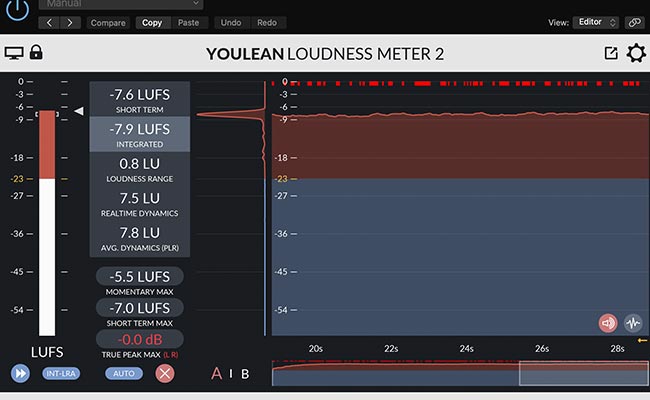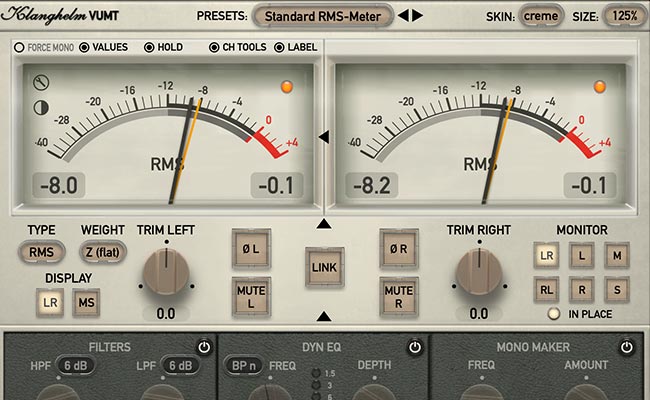LUFS and RMS are both measurements used to describe the level of a sound signal, but they represent different aspects of the signal. RMS measures the physical power of a signal, while LUFS measures the perceived loudness of a signal, taking into account the human ear’s frequency response and loudness perception.
That’s the short explanation, but let’s break things down further to truly get a handle on this topic.
LUFS Vs RMS
In audio engineering, LUFS and RMS are often confused or used interchangeably, but they actually represent different aspects of the sound signal.
RMS stands for Root Mean Square, which is a measure of the average power of a signal.
It is a mathematical calculation that takes into account the amplitude of the signal over time, and provides a value that represents the average power of the signal over a given time period. RMS is often used in audio engineering to describe the loudness of a signal, and it is used to set appropriate levels for recording, mixing, and mastering.
On the other hand, LUFS stands for Loudness Units Full Scale, and it is a measure of the perceived loudness of a sound signal. LUFS takes into account the human ear’s perception of loudness, and it measures the level of a signal in relation to a reference level.
The reference level is usually set at the maximum digital level, which is 0 dBFS. LUFS is used to ensure that the loudness of a sound signal is consistent across different playback systems and platforms.

Want a Less Technical Explanation?
One way to understand the difference between RMS and LUFS is to think of RMS as a measure of the physical power of a signal, while LUFS is a measure of the perceived loudness of a signal.
For example, two signals with the same RMS value can sound different in loudness if they have different frequency content or dynamic range. LUFS takes into account these factors to provide a more accurate measure of the loudness of a sound signal.
Another difference between RMS and LUFS is the way they are measured. RMS is measured using a meter that displays the signal’s amplitude over time, while LUFS is measured using a specialized meter that takes into account the human ear’s frequency response and loudness perception. LUFS meters are calibrated to provide a reading that is consistent across different types of audio content, such as music, speech or sound effects.
In terms of their practical applications, RMS and LUFS are used in different contexts in audio engineering. RMS is often used in recording and mixing to set appropriate levels for each element of a mix, such as vocals, drums, or guitars. It is also used in mastering to ensure that the final mix has a consistent loudness level.
LUFS, on the other hand, is used in broadcast, streaming, and other delivery platforms to ensure that the loudness of a sound signal is consistent across different devices and playback systems. This is important because different devices and platforms can have different loudness levels, and a signal that is too loud or too quiet can result in a poor listening experience for the audience.

Why Has LUFS Become the Standard in Mastering?
Historically, mastering engineers referred to RMS as their primary measurement. Indeed, some still do, and most of us still reference RMS as one of our meter checks.
However, LUFS is becoming the standard for loudness over RMS because it takes into account the human ear’s frequency response and loudness perception. RMS only measures the physical power of a signal, which may not accurately represent how loud the signal sounds to the human ear.
In contrast, LUFS meters are calibrated to provide a reading that is consistent across different types of audio content, such as music, speech or sound effects. This means that the loudness of a sound signal can be accurately measured and adjusted to ensure a consistent listening experience for the audience across different playback systems and platforms.
For this reason, streaming sites like Spotify and YouTube now use LUFS as their loudness measurement standard.
In Summary
While RMS and LUFS are both measures of the loudness of a sound signal, they represent different aspects of the signal. RMS measures the physical power of a signal, while LUFS measures the perceived loudness of a signal. Both measurements have their practical applications in audio engineering, and understanding the difference between them is important for achieving optimal sound quality in different contexts.

